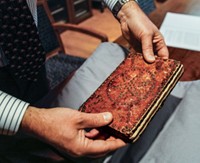Advertisement
Grab your lab coat. Let's get started
Welcome!
Welcome!
Create an account below to get 6 C&EN articles per month, receive newsletters and more - all free.
It seems this is your first time logging in online. Please enter the following information to continue.
As an ACS member you automatically get access to this site. All we need is few more details to create your reading experience.
Not you? Sign in with a different account.
Not you? Sign in with a different account.
ERROR 1
ERROR 1
ERROR 2
ERROR 2
ERROR 2
ERROR 2
ERROR 2
Password and Confirm password must match.
If you have an ACS member number, please enter it here so we can link this account to your membership. (optional)
ERROR 2
ACS values your privacy. By submitting your information, you are gaining access to C&EN and subscribing to our weekly newsletter. We use the information you provide to make your reading experience better, and we will never sell your data to third party members.
Synthesis
Turning Art into Gold
Foundation, museum join forces to put together traveling alchemy art exhibition
by Patricia Short
September 26, 2005
| A version of this story appeared in
Volume 83, Issue 39

The event seems like an awfully long time away, but this month, the Chemical Heritage Foundation (CHF) and the Philadelphia Museum of Art (PMA) officially begin organizing a traveling exhibition about art and alchemy for 2009.
The exhibition will open in Philadelphia that year, and subsequently will travel to several other U.S. and European venues.
The exhibition is part of a new CHF outreach program that will be supported by galleries the foundation will begin building next year. The foundation also is contributing to a six-hour program on the history of chemistry planned for prime-time television. And next year, it will host an international conference on alchemy to celebrate installation of the Roy G. Neville Historical Chemical Library.
The conference is expected to provide an opportunity to extend what CHF calls "the significant advances in our understanding of the early history of chemistry made in the past two decades." Included will be papers covering Paracelsus and his followers, the Paracelsians; the 17th-century chemist-entrepreneur Johann Rudolf Glauber; the 18th-century theorist of phlogiston, Georg Ernst Stahl; and alchemy in the Islamic world.
But the exhibition will take that outreach program one step further. The concept developed from a history-of-science conference held in Paris last year on the public image of chemistry. A press conference had been planned to gather a group of chemical industry and science journalists to discuss CHF developments affecting chemistry professionals in Europe and to get input on CHF programs, recalls Communications Manager Neil Gussman.
"But the results were not what we expected," he says. Instead, the interest at the press conference was in alchemy art. And in the three days of the conference that followed, Gussman adds, the question came up a number of times as to whether it would be possible for CHF to create a collection of alchemy art for exhibition in European museums--a project that has now been crystallized.
"We have a very concentrated collection of chemical-related art," says Robert D. Hicks, director of CHF's Roy Eddleman Institute for Interpretation & Education. "This is our first real effort to do this kind of exhibition, to bring the art to a broader public. We are now raising money for this and securing venues for the exhibition."
Key to the project, CHF art curators say, has been agreement by the American Federation of Arts to partner on the project. The federation will help organize and administer the exhibit, publish the catalog, and produce educational materials.
The exhibit will explore the evolution of European alchemical thought and practice from the 16th to the 19th centuries through manuscript illuminations, metalwork, paintings and prints, and books of secrets.
The core objects in the exhibit will be drawn from the Chester G. Fisher and Eddleman Collections of alchemical art and the Neville Collection of rare books at CHF. PMA will loan several works. And other rarely exhibited objects will be borrowed from the private collection of Isabel and Alfred Bader and from other museum collections.
Lloyd de Witt, assistant curator of the John G. Johnson Collection at PMA, says, "We are trying to bring together not just the paintings, but illuminations and papers from the alchemists." The exhibition will detail the work of believers and of skeptics. "By bringing all these objects together, we will show the artistry and the richness of the science," de Witt adds.
Throughout its history, alchemy enjoyed broad intellectual and practical appeal, CHF researchers enthuse: The alchemical quest to transmute base metals into gold and to produce an elixir to prolong life captivated artisans and nobles alike. Practitioners included itinerant quacksalvers, barber-surgeons, apothecaries and physicians, and scholars and natural philosophers.
According to CHF researchers, at issue was the question of man's moral boundaries concerning the manipulation of nature. The work of the alchemists led to a new concept of "science" developed with the acceptance of observation, experimentation, and mathematical descriptions. Visitors, CHF hopes, will come away with a better sense of the debt that modern science owes to alchemy.
"These will be top-quality, very impressive, and beautiful images--something for the scholars, but also for the public," deWitt says.
"We have the committee together now, and we are writing our first application for a National Endowment for the Humanities grant--which is very scary," he adds.




Join the conversation
Contact the reporter
Submit a Letter to the Editor for publication
Engage with us on Twitter